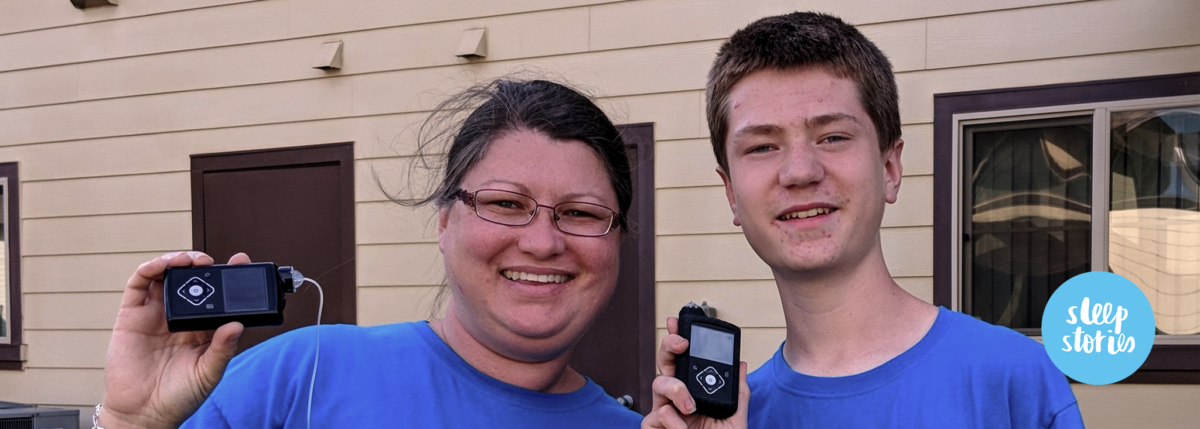A Parent’s Worry with T1D
This content was made possible with support from Medtronic Diabetes, an active partner of Beyond Type 1 at the time of publication.
“Not much.” That’s my typical answer when asked the common question, “How did you sleep last night?”
When you live with type 1 diabetes, sleep is often interrupted for one reason or another. Your blood sugar drops dangerously low. Your pump starts beeping demanding a calibration. Your pump alerts you because your blood glucose is too high. Your pump beeps right before your alarm is set to go off because you need to refill your insulin, so you get up and change your infusion set.
If you also have a child with Type 1 diabetes you can’t get your mind to slow down because you are thinking any of those things could be happening to him and he might not realize it. When your child doesn’t have a pump to alarm, you sleep even less due to the worry of the unknown – without a pump and sensor there is nothing besides you to monitor your child and correct their blood sugar levels if needed.
The start of our journey
When my son, Alan, was diagnosed with type 1 diabetes at the age of 14 it took me six months before I slept through the night, and then it only happened occasionally. The first six months following Alan’s diagnosis the doctors had him doing multiple daily injection (MDI) therapy. Learning how to take care of Type 1 diabetes is challenging and they wanted to be sure he could learn how his body felt when his blood sugars were changing. They also wanted him to be capable of taking care of himself without depending on technology. He was really good at being responsible and checking his blood sugar levels when he was supposed to, counting carbs, taking his shots, and asking for help when he needed it. During the day he did a great job taking care of himself and we didn’t worry about him too much.
The unknown of overnights
It was after bedtime that the worry set in. I found myself tossing in bed and wondering would his blood sugar get so high during the night he might go into diabetic ketoacidosis (DKA)? Would he wake up if his blood sugar went low? Would he go so low he might not wake up at all? These were just a few of the thoughts that ran on a loop cycle in my head throughout the night.
I set an alarm for 2 a.m. every morning and woke up to go into his room and check his blood sugar to make sure he was doing OK. There were nights where his numbers were great and he slept through the fingerstick. But there were also nights when his blood sugar was low and I had to wake him to eat something. Then we had to wait 15 minutes and check his blood sugar again to see if it was at a safe level for him to go back to sleep or if we needed him to eat more and wait another 15 minutes to check again. There were also nights when his blood glucose levels were high and I had to wake him to give an injection to correct the blood sugar. I would often get up two to three hours later and check him again to make sure his blood sugar was coming down like it should.
Pulling from my own experience
Alan and I have a connection I don’t always wish was the case. I also have type 1 diabetes, so as much as I always want to put my kids first, there are nights when my blood sugar drops low and I have to take care of myself.
When that occurs, my husband goes in to check on Alan during the night, even though he has to wake up early for work in the morning. Diabetes is a 24-hour a day, 365 day a year job, and it is one that our whole family works together to manage.
Overnights with an insulin pump
Once Alan had demonstrated he could manage his diabetes on multiple daily injection (MDI) we started talking about insulin pumps. We knew the many benefits of getting good control of your diabetes with an insulin pump because I have been using one since 2001, and today I use the MiniMed™ 670G system. One of the best things about using an insulin pump with continuous glucose monitoring (CGM) is the alarms. I know a lot of pumpers complain about how many alarms the pump has and how it interrupts what you are doing, but as a parent I am grateful for the safeguards.
Today, Alan also uses the MiniMed™ 670G insulin pump system and now I don’t feel the need to get up in the middle of the night every night to check on him. Those pesky alarms from the pump will wake him up if needed, and if he misses them, they increase in volume so that I can go in and check on him. Alan still checks his blood sugar before he goes to bed to be sure the CGM and his fingerstick numbers are close, and there are still some times we wake up to do a fingerstick, but now we can say we sleep through the night more often than not and we all worry a lot less.
The testimonial above relates an account of an individual’s experience using a Medtronic device. The account is genuine, typical and documented. However, this individual’s experience does not provide any indication, guide, warranty or guarantee as to the response or experience other people may have using the device. The experience other individuals have with the device could be different. Experiences can and do vary. Please talk to your doctor about your condition and the risks and benefits of Medtronic devices.
Important Safety Information
MINIMED 670G SYSTEM
The Medtronic MiniMed™ 670G system is intended for continuous delivery of basal insulin (at user selectable rates) and administration of insulin boluses (in user selectable amounts) for the management of type 1 diabetes mellitus in persons, seven years of age and older, requiring insulin as well as for the continuous monitoring and trending of blood glucose levels in the fluid under the skin. The MiniMed™ 670G system includes SmartGuard™ technology, which can be programmed to automatically adjust delivery of basal insulin based on Continuous Glucose Monitor sensor glucose values and can suspend delivery of insulin when the sensor glucose value falls below or is predicted to fall below predefined threshold values. The system requires a prescription. The Guardian™ Sensor (3) glucose values are not intended to be used directly for making therapy adjustments, but rather to provide an indication of when a fingerstick may be required. A confirmatory finger stick test via the CONTOUR®NEXT LINK 2.4 blood glucose meter is required prior to making adjustments to diabetes therapy. All therapy adjustments should be based on measurements obtained using the CONTOUR®NEXT LINK 2.4 blood glucose meter and not on values provided by the Guardian™ Sensor (3). Always check the pump display to ensure the glucose result shown agrees with the glucose results shown on the CONTOUR®NEXT LINK 2.4 blood glucose meter. Do not calibrate your CGM device or calculate a bolus using a blood glucose meter result taken from an Alternative Site (palm) or from a control solution test. It is not recommended to calibrate your CGM device when sensor or blood glucose values are changing rapidly, e.g., following a meal or physical exercise. If a control solution test is out of range, please note that the result may be transmitted to your pump when in the “Always” send mode.
| WARNING: Medtronic performed an evaluation of the MiniMedTM 670G system and determined that it may not be safe for use in children under the age of 7 because of the way that the system is designed and the daily insulin requirements. Therefore this device should not be used in anyone under the age of 7 years old. This device should also not be used in patients who require less than a total daily insulin dose of 8 units per day because the device requires a minimum of 8 units per day to operate safely. |
Pump therapy is not recommended for people whose vision or hearing does not allow recognition of pump signals and alarms. Pump therapy is not recommended for people who are unwilling or unable to maintain contact with their healthcare professional. The safety of the MiniMed™ 670G system has not been studied in pregnant women. For complete details of the system, including product and important safety information such as indications, contraindications, warnings and precautions associated with system and its components, please consult http://www.medtronicdiabetes.com/important-safety-information#minimed-670g and the appropriate user guide at http://www.medtronicdiabetes.com/download-library





